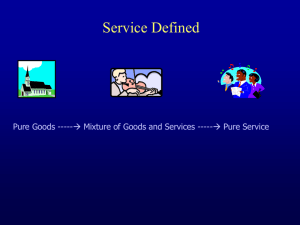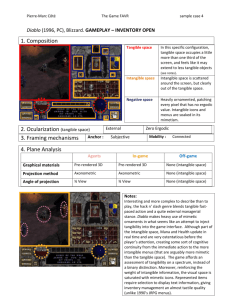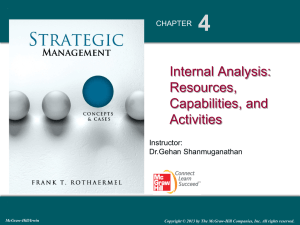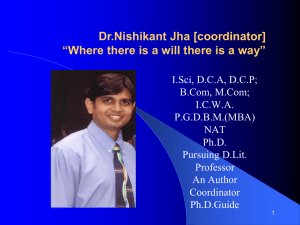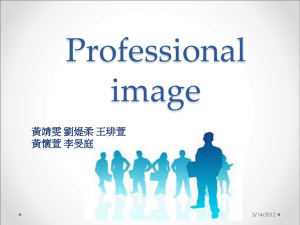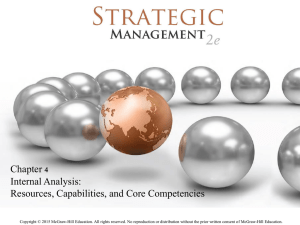SERVICE MARKETING
advertisement
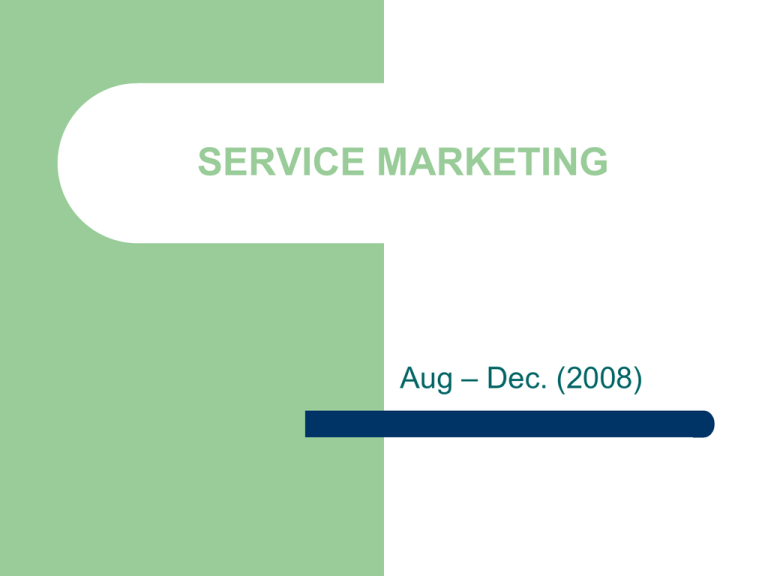
SERVICE MARKETING Aug – Dec. (2008) SERVICES “Service is an act or performance offered by one party to another that is essentially intangible and does not result in the ownership of anything.” TRENDS IN SERVICES SECTOR Service industry known as tertiary industry (primary – agri, mining; secondary – manufacturing) Share of services, industry, and agriculture in India's GDP is 55.1 per cent, 26.4 per cent, and 18.5 per cent respectively A KPMG survey of BRIC countries (Brazil, Russia, India and China), has revealed highest confidence among the service sector in India with 60% of the Indian firms expect rise in activity, a few notches above than that of China TRENDS IN SERVICES SECTOR Factors contributing to growth: 1. Government Policies – – Govt. regulations, Privatisation 2. Social Changes – – – Rising customer expectations More affluence Increased desire for buying experiences vs products TRENDS IN SERVICES SECTOR Factors contributing to growth: Business trends 3. – – – Mfrs. Adding value through services Quality Movement Growth of franchising Advances in Information Technology 4. – – Growth of internet Convergence of computers & telecommunications Internationalisation 5. – – More cos. operating on transnational basis International mergers & aquisitions TRENDS IN SERVICES SECTOR The various sectors that combine together to constitute service industry in India are: Trade Hotels and Restaurants Railways Other Transport & Storage Communication (Post, Telecom) Banking Insurance Dwellings, Real Estate Business Services Public Administration; Defence Personal Services Community Services Other Services TRENDS IN SERVICES SECTOR While almost all service sectors participated in this boom, growth was fastest in communications, banking, hotels and restaurants, trade and business services. INTERNAL SERVICES Service elements within an organization that facilitate creation of--or add value to--its final output Includes: – accounting and payroll administration – recruitment and training – legal services – transportation – catering and food services – cleaning and landscaping Increasingly, these services are being outsourced GOODS AND SERVICES Differences between goods & services Customers do not obtain ownership of services Service products are ephemeral & cannot be inventoried Intangible element Customers maybe involved in production process Other people part of product GOODS AND SERVICES Differences between goods & services Greater variability in operational inputs & outputs Services are difficult for customers to evaluate Time factor assumes more importance Distribution channel take different forms Hi Value Added by Tangible vs Intangible Elements in Goods and Services Salt Soft drinks CD Player Golf clubs New car Tailored clothing Furniture rental Fast food restaurant Lo Plumbing repair Office cleaning Health club Airline flight Retail banking Insurance Weather forecast Intangible Elements Hi CLASSIFICATION OF SERVICES A significant classification is based on process (taking an input & transforming into an output) Marketers of services need to understand nature of services to which customers are exposed Services range from simple procedures to highly complex activities CLASSIFICATION OF SERVICES People Possession People Processing Possession processing - Passenger transportation - Freight transportation - Health care - Repair & maintenance - Lodging & Restaurant - Retail distribution Tangible actions Mental stimulus - Advtg. & PR - Education - Entertainment & Arts Intangible actions Information processing - Accounting & Bkg - Insurance & Legal - Software Consulting CLASSIFICATION OF SERVICES 1. People processing Customers must physically enter the service system as they are integral part of process They must spend time interacting & cooperating with service providers Process & output is important CLASSIFICATION OF SERVICES 2. Possession processing Providing treatment to possession. Customers less physically involved Customer’s involvement – to drop item that needs treatment, requesting the service, explaining problem & later picking it up & paying the bill. If object to be processed is difficult to move then “service factory” comes to customer CLASSIFICATION OF SERVICES 3. Mental stimulus processing These services interact with the customer’s minds which has the power to shape their attitude & behaviour. Core content is information Customers not physically present, but mentally connected with information presented. Recipients have to make investment of time CLASSIFICATION OF SERVICES 4. Information processing Information is most intangible but can be made tangible by letters, reports, books Financial & professional services are strong examples of collection & processing of information No requirement of personal contact with supplier of service. Contact could be over e-mail, telephone. IMPLICATIONS OF SERVICE PROCESS 1. Designing Service Factory (people proc.) When customers have to be physically present throughout delivery, process must be designed with them in mind – right from the moment they arrive the service factory. Choose convenient location These factors assume importance – – – – exterior & interior facilities, encounters with service personnel, interactions with self-service equipment characteristics of other customers IMPLICATIONS OF SERVICE PROCESS 2. For possession-processing, mental-stimulus processing, or information processing services, alternatives include: 1. Customers come to the service factory 2. Customers come to a retail office 3. Service employees visit customer’s home or workplace 4. Business is conducted at arm’s length through - physical channels (e.g., mail, courier service) - electronic channels (e.g., phone, fax, email, Web site) IMPLICATIONS OF SERVICE PROCESS 3. Making most of Information Technology All services can benefit from IT, but mental stimulus processing and information- processing services have the most to gain. Remote delivery of information-based services “anywhere, anytime” New service features through websites, email, and internet (e.g., information, reservations) More opportunities for self-service IMPLICATIONS OF SERVICE PROCESS 4. Balancing Supply & Demand Problems arise because service output can’t be stored If demand is high and exceeds supply, business may be lost. If demand is low, productive capacity is wasted Services that process people & possession face more capacity limitations. Increasing capacity entails huge costs. Managing demand becomes more important. IMPLICATIONS OF SERVICE PROCESS 5. People becoming part of Product When people become part of service, their attitude, behaviour & appearance can enhance it or detract it Managers should be concerned about employees’ appearance, social skills, technical skills SERVICES MARKETING MIX Product Place & Time Promotion & Education Price Physical Environment Process People INTERDEPENDENCE OF MARKETING, OPERATIONS & HR Operations Management Marketing Management Customers Human Resources Management SERVICE BUSINESS – AS A SYSTEM Three Overlapping Sub-systems Service Operations (front stage and backstage) Where inputs are processed and service elements created. Includes facilities, equipment, and personnel Service Delivery (front stage) Where “final assembly” of service elements takes place and service is delivered to customers Includes customer interactions with operations and other customers Service Marketing (front stage) Includes service delivery (as above) and all other contacts between service firm and customers SERVICE MARKETING SYSTEM High Contact Service Service Delivery System Other Contact Points Service Operations System Other Customers Interior & Exterior Facilities Technical Core Equipment The Customer Service People Backstage (Invisible) Front Stage (Visible) Other Customers Advertising Sales Calls Market Research Surveys Billing / Statements Miscellaneous Mail, Phone Calls, Faxes, etc. Random Exposure to Facilities / Vehicles Chance Encounters with Service Personnel Word of Mouth SERVICE MARKETING SYSTEM Low Contact Service Service Delivery System Service Operations System Other Contact Point Advertising Mail Technical Core Self Serv. Equipment Customer Customer Market Research Surveys Word of Mouth Phone, Website Backstage Front stage Theatre – A Metaphor for Service Delivery • Service facilities is the stage on which drama unfolds. Some cases customer’s own facilities provide stage. • Stage can have minimal props or very elaborate • Service dramas could be tightly scripted or improvisational • Settings change from one act to another • Front stage personnel play roles of actors ( sometimes wearing costumes) supported by backstage production team SERVICE PLANNING SERVICE PLANNING Corporate Objectives and Resources Marketing Assets Operating Assets (Customer Base, Mkt. Knowledge, Implementation Skills, Brand Reput.) (Facilities/Equipment, IT Systems, People, Op. Skills, Cost Structure) Service Marketing Concept Service Operations Concept •Benefits to customer from core/ supplementary elements, style, service level, accessibility •Nature of processes •Geographic scope of ops •Scheduling •Facilities design/layout •HR (numbers, skills) •Leverage (partners, self-service) •Task allocation: front/backstage staff; customers as co-producers •User costs/outlays incurred •Price/other monetary costs •Time •Mental and physical effort •Neg. sensory experiences Service Delivery Process SERVICE PLANNING 1. Starts with statement of objectives or mission at corporate leve 2. This mission leads to two types of analysis – SWOT Analysis identifying strengths, weaknesses, opportunities & threats on marketing & operations fronts – Market & Competitive Analysis – Resource Allocation analysis – appraisal of firm’s resources, how to allocate them & identifying additional resources SERVICE PLANNING 3. Each analysis draws two statement of assets a. Marketing assets statement which includes – customer portfolio, market knowledge, marketing implementation skill, product line, reputation of brands & positioning strategies. b. Operating assets statement which includes – Physical facilities, equipment, Information technology, H.R. (numbers & skill), alliances & partnerships, cost SERVICE PLANNING 4. Statement of assets leads to creation of the following concepts. This must be an interactive process. a. Service marketing concept to clarify benefits to customers & costs they shall incur b. Service operating concept clarifies nature of processes & how & when operating assets should be deployed 5. Set of choices before the management in configuring delivery process.
